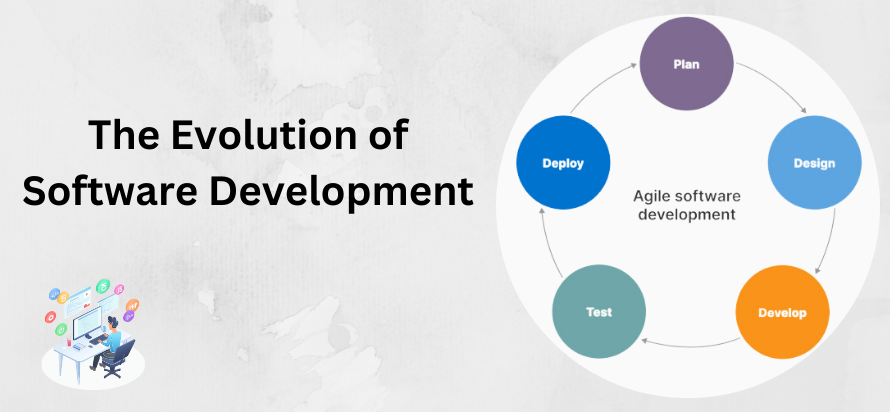Over the years, the world of software development has seen a striking transformation. The evolution of software development approaches, from its modest beginnings with the Waterfall methodology to the dynamic and iterative practices of Agile and beyond, illustrates the sector's pursuit of effectiveness, adaptability, and customer-centricity. We'll examine the progression of application development approaches in this blog article, charting the route from Waterfall to Agile and examining the fascinating possibilities that lay ahead.
The waterfall Era
The introduction of codified software development procedures was marked by the Waterfall approach. The Waterfall methodology, which first appeared in the 1970s, consisted of the following phases: requirements, design, implementation, testing, deployment, and maintenance. Each step was separate and only moved forward after the one before it was finished. To ensure clarity and prevent scope revisions in the middle of the project, this rigorous framework was used.
However, as software projects became more complicated, Waterfall started to show its limitations. The strategy was too rigid to adapt to shifting needs or unforeseen difficulties. Project teams frequently found themselves stuck with fixed plans that couldn't change when conditions did. As a result, it was clear that we needed a more flexible and adaptable process.
The rise of agile methodology
The Agile technique emerged in the early 2000s, ushering in a paradigm shift in software development. Agile places more emphasis on adaptability, teamwork, and iterative development than on rigid adherence to preset plans. It sought to provide value gradually while actively seeking customer feedback for ongoing development.
Key concepts that emphasized people and relationships, functional software, customer collaboration, and adapting to change were articulated in the Agile Manifesto, which was published in 2001. Small, cross-functional teams, frequent releases, and a focus on the client were all stressed in this new methodology.
This methodology plays a pivotal role in CRM (Customer Relationship Management) and POS (Point of Sale) software development by fostering adaptability and customer-centricity. In the context of CRM, Its iterative approach enables continuous refinement of features based on real-time customer feedback, ensuring the system aligns with evolving business needs. Similarly, in POS software development, Its flexibility allows for quick responses to changing market demands, enabling seamless integration of new payment methods and features. By emphasizing collaboration, regular feedback, and incremental development, it optimizes both CRM and POS projects for enhanced functionality, user satisfaction, and a competitive edge in dynamic business environments.
Benefits of agile methodology
Numerous advantages were brought to the fore by agile approaches. Its iterative structure made it possible for teams to adjust to shifting needs, lowering the chance of delivering a solution that did not meet users' needs. The final product was in line with customer expectations thanks to frequent feedback loops with stakeholders.
Agile also encourages better communication between stakeholders and team members. Communication barriers were removed, resulting in a more open and cooperative atmosphere. Teams were compelled to give priority to measurable results because of Agile's emphasis on working with software rather than paperwork.
Challenges in scaling agile and hybrid approaches
Agile approaches changed the way software was developed, but they weren't without problems. These teams had to carefully coordinate with one another while scaling up to larger projects or organizations. SAFe (Scaled Agile Framework) and LeSS (Large Scale Scrum) were born out of this need to spread Agile ideas throughout businesses.
Hybrid techniques also came into being as software development continued to advance. To achieve a balance between agility and efficiency, these methods merged components of Agile methodology with techniques from other fields, such as DevOps.
The future of embracing continuous evolution
Software development approaches will likely continue to evolve and incorporate the best elements of both Agile and traditional methodologies. Organizations are investigating how to speed up development, testing, and deployment by fusing Agile and DevOps approaches. Additionally, with the growth of AI and machine learning, it is possible to incorporate these technologies into the development process, improving predictive analytics, automating testing, and improving project management.
It is also anticipated that the focus on user feedback and customer centricity will remain crucial. The capacity to develop solutions that genuinely meet user demands will only become more crucial as software becomes more pervasive in our daily lives.
Conclusion
The evolution of the development of software approaches, from Waterfall's inflexible structure to Agile's dynamic flexibility and beyond, illustrates the sector's unrelenting quest for effectiveness, adaptability, and customer happiness. Its approaches, which encourage teamwork, adaptability, and customer-centricity, transformed how software is built and delivered.


